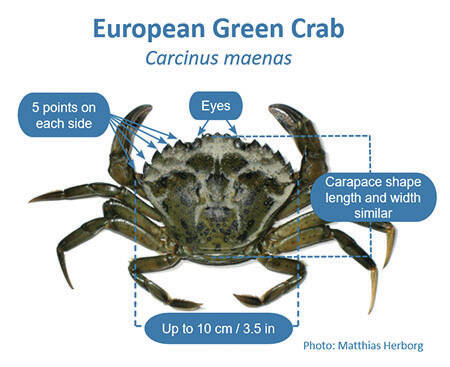Alaska’s fish and game experts are keeping their eyes on a new aquatic invasive species that was newly detected in Southeast last month.
Live European green crabs, which have been present for decades on the East Coast of the United States, are among the top 100 worst invasive species, as ranked by the Global Invasive Species Database.
The crabs were first observed in Alaska on July 19 at the Annette Islands Reserve in Southeast Alaska. That reserve is home to the Metlakatla Indian Community, which had trapped 32 live crabs from Tamgas Harbor as of Aug. 18.
Among the lineup of last week’s Kenai Classic Roundtable on Fisheries, hosted at Kenai Peninsula College by the Kenai River Sportfishing Association, was a panel on aquatic invasive species. That panel included Tammy Davis, an invasive species program coordinator with the Alaska Department of Fish and Game.
While European green crab were on the department’s radar, Davis said, their detection in Southeast came earlier than expected.
“We all thought we had more time before they would be found in Alaska,” Davis said.
Modeling out of Portland State University, Davis said, found that a 1 degree increase in ocean temperature, such as in the case of “The Blob,” would make “much of Alaska” suitable for green crab.
A 1 degree increase in ocean temperatures has been observed in a phenomenon known as “The Blob.” Per the National Park Service, “The Blob” refers to a large mass of warm water in the Pacific Ocean that was first detected in 2013 that has been linked to changes in climate and ocean ecosystems.
Davis wrote in an article published by the Department of Fish and Game in May 2021 that Southeast’s marsh habitats are “ideal” for the crabs to be established. At the time the article was published, the crabs had not yet been detected in Alaska, but were reported in the Haida Gwaii archipelago in British Columbia.
The primary concern when it comes to European green crabs is potential negative impacts on local fisheries and habitat disturbance. The Department of Fish and Game has raised specific concerns about damage to eelgrass, which provide refuge for juvenile salmonoids, and the crabs’ preferred prey of native clams, mussels and snails.
“The establishment of green crab in Alaska waters could result in detrimental changes in intertidal ecosystem dynamics,” a Department of Fish and Game webpage on the crabs says.
Though called green crabs, their shells can vary in color. The crabs are more easily identified by the five points, or spines, between a crab’s eye and front pincher. There are two sets of five spines on either side of the wide part of the cab’s shell. There are also three rounded lobes between a European green crab’s eyes.
The number of spines on the green crab differentiate it from juvenile Dungeness crabs, which have 10 spines.
Via humans, European green crabs can move via aquariums and live food trades, among other things. More concerning to Alaska, the Department of Fish and Game says, is the ability of crab larvae to move by way of ocean currents. The crabs prefer protected estuaries and bays with minimum wave action, as well as salt marshes.
News of the European green crab’s arrival in Alaska comes as the Kenai Peninsula has been declared free of invasive northern pike. That’s per Davis, who told attendees at last week’s event that the peninsula is free of the invasive fish.
Pike, native to areas in Alaska north of the Alaska Range, were being treated by the Alaska Department of Fish and Game in partnership with the Kenai National Wildlife Refuge as recently as last spring on the Kenai Peninsula. The species threaten native fish populations, including rainbow trout and juvenile salmon.
Alaskans are encouraged to report all suspected sightings of invasive species, including European green crab. The department urges Alaskans to take photos of, rather than collect, any found invasive species. Observations can be reported through the Alaska Department of Fish and Game’s Invasive Species Reporter, which can be accessed on the department’s website. The invasive species hotline is 1-877-INVASIV.
More information about European green crabs can be found on the department website at adfg.alaska.gov under the “Invasive Species” tab.
Reach reporter Ashlyn O’Hara at ashlyn.ohara@peninsulaclarion.com.

